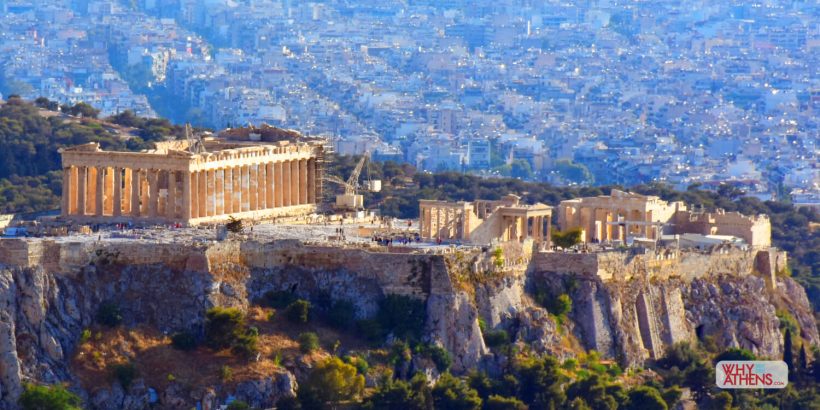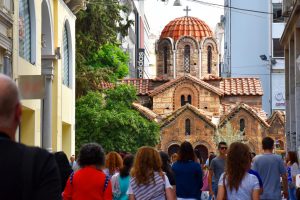The Acropolis, with its towering buttress walls that project dramatically skyward in central Athens, has been a focus of human attention for more than three millennia. Our contributing archaeologist John Leonard explores how the Acropolis, as we know it today, came to be, under the leadership of the influential, democratically-minded statesman, Pericles.
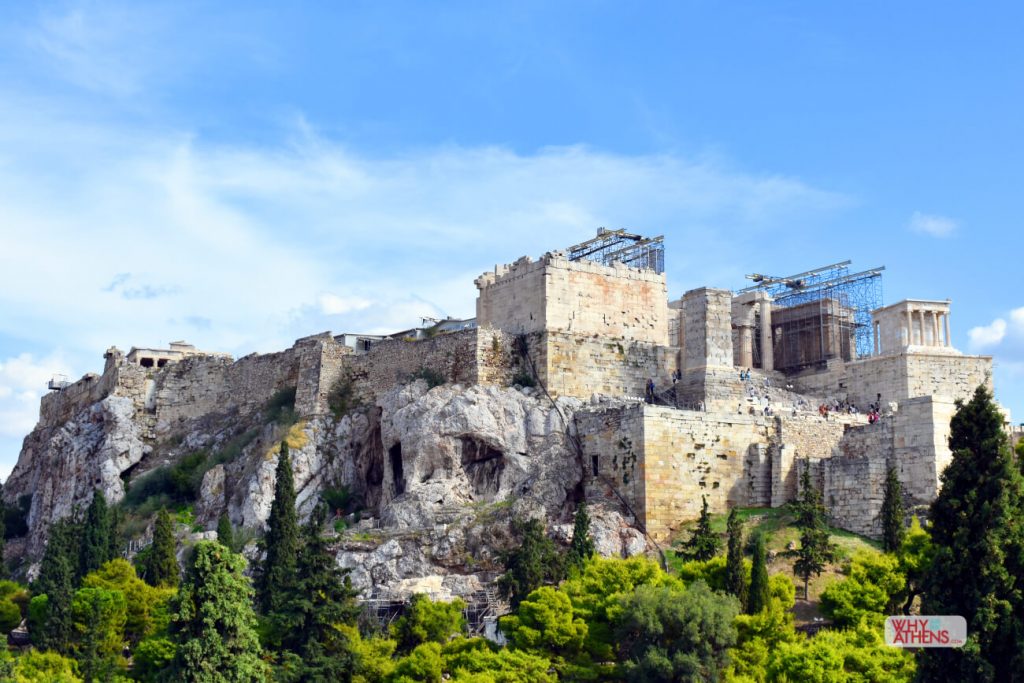
The sheer rocky slopes and towering walls of the Acropolis. Photograph: Why Athens
By the Late Bronze Age (13th c. BC), the Mycenaeans had taken over this naturally defensible hill, known today as the Sacred Rock, and established a palace surrounded by 10 metre high “Cyclopean” walls – so massive (thought later Greeks) that only Homeric giants like Polyphemus and his kin could have constructed them. Nevertheless, these stout defences were eventually thrown down in 480 BC by the invading Persians and later buried by the Classical-era builders of the Parthenon (447-438 BC) as they prepared the ground for their new, elegantly ornamented temple dedicated to Athena, which would become the everlasting symbol of Classical Athens’ Golden Age.
Athens in the first half of the 5th century BC was a city in turmoil and transition as it fended off Persians, marshalled its allies and sought a new role as ancient Greece’s leading city state. Its domestic politics were also shifting, with ordinary citizens bristling against their aristocratic or oligarchic leaders and demanding a more democratic government.
Skip the line e-tickets with an audio tour are available to purchase here in advance
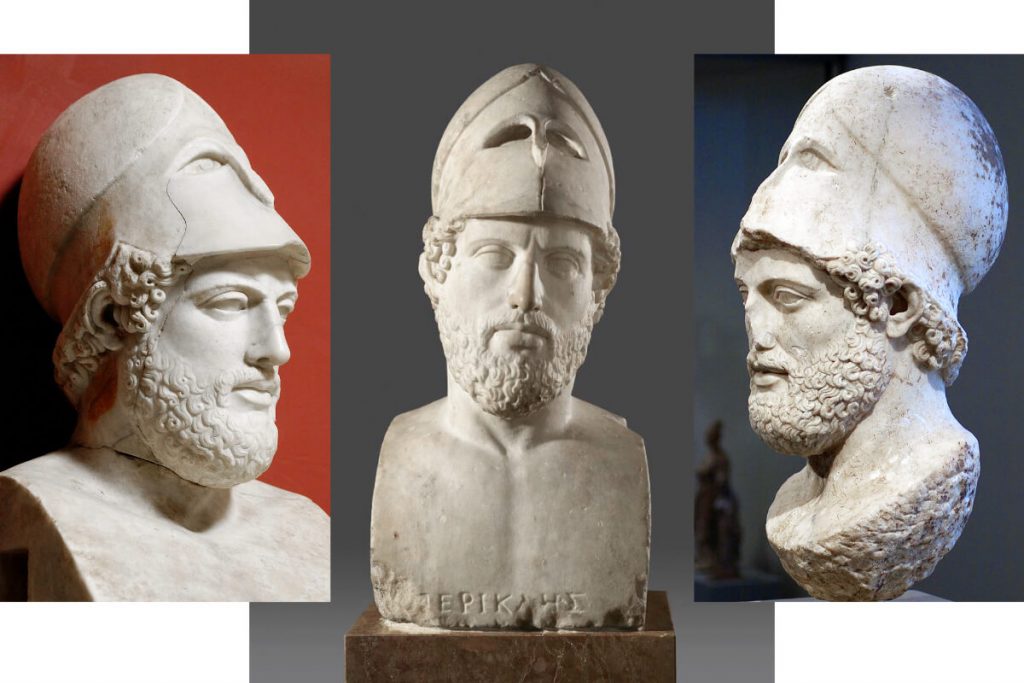
Athenian statesman and general Pericles in his Corinthian helmet survives in four Roman era marble copies. L to R: the Vatican Museum copy, the British Museum copy, the Berlin Altes Museum copy. (not pictured Rome Baracco Museum copy)
Pericles emerged in the 460s BC, an ambitious young politician, himself an aristocrat, who either truly sympathised with the needs of his less-advantaged fellow Athenians or perceived their democratic desires as a convenient vehicle for his own ascendancy to power. Whatever his initial motivation, Pericles became a great champion of democracy and advocate for women’s rights. He also galvanised ancient Athenians with his bold promotion of their social, political and military superiority, in part through the monumental building program of the Acropolis.
Before the Acropolis became a giant pro-Athenian, pro-Periclean “billboard” in the second half of the 5th century BC, it was the deeply revered religious nucleus of Athens, where not only Athena was worshiped, but numerous other gods, goddesses and local heroes. The summit’s centre and southern side were most sacred, as these spots accommodated a series of structures dedicated to the city’s divine patroness, Athena, including a Late Geometric temple, the “Hekatompedon” or “Bluebeard temple”, the Old Athena Temple (Archaios Naos) and the Pre-Parthenon.
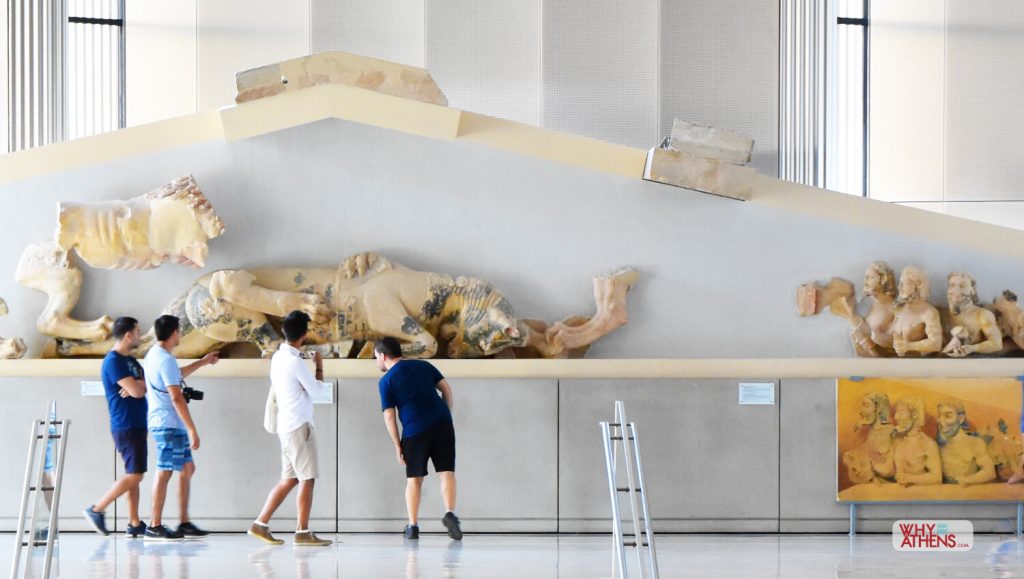
Several structures stood prior to where Pericles’ Parthenon is built, including the Hekatompedon, the remains of which (pictured here) are on display at the Acropolis Museum, dating back to 570BC. Photograph: Why Athens
Scattered across the hilltop were additional shrines dedicated to various figures that presumably included some or all of those worshiped (Poseidon, Erechtheus, Hephaestus, Hermes, Zeus Herkeios, Kekrops, Pandrosos and Boutes) in the later constructed Erechtheion (430s-406 BC), a uniquely designed building intended to concentrate many of the Acropolis’ traditional cults within one monumental, multi-purpose structure.
When Pericles began reorganising and renovating the Acropolis in the 440s BC, he started with the Parthenon, a tribute to the great goddess Athena, but also to the city and its people. The pre-Greek name “Athene,” some specialists argue, may have been the original name of the Acropolis, and of the Iron Age settlement on top, which did not take its name from the goddess, but gave its name to her – a female deity already known in the Late Bronze Age – whose primary symbols in Athens (owl, snake, olive tree) were all timeless natural features of the rugged hill. She personified qualities the Athenians identified as their own: military prowess, fearlessness, love of beauty, reason, moderation and knowledge. Thus, she embodied the city and its citizens.
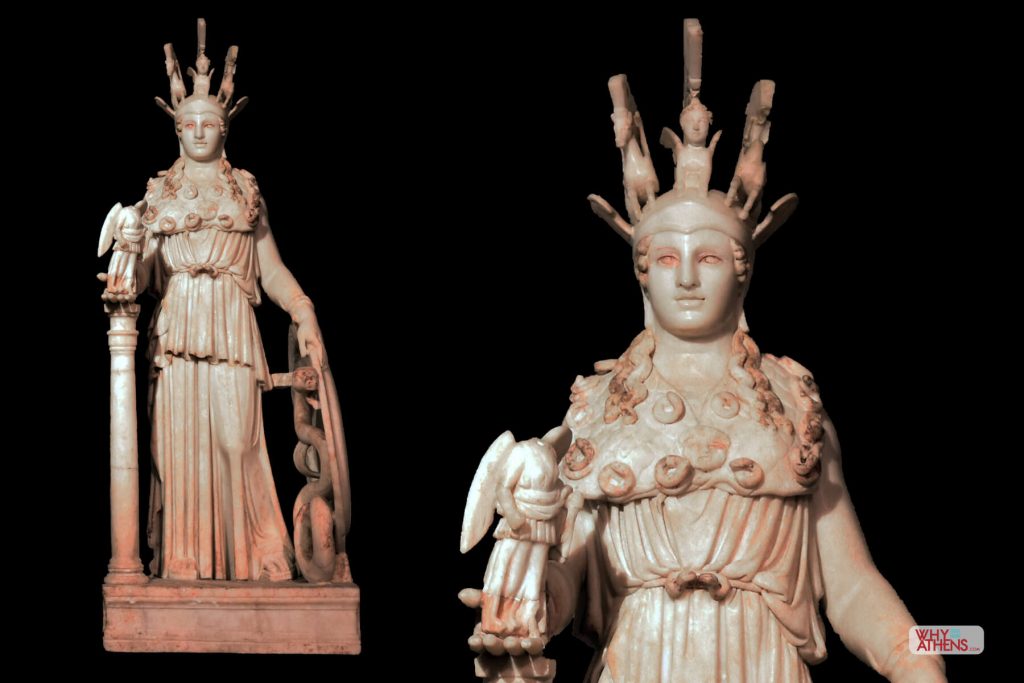
Athena Parthenos by Pheidias was thought to have been erected inside the Parthenon around 438BC. She holds the winged Nike in her right palm and shield in her left hand. This statuette made of Pentelic Marble circa 200-250AD was found at the Varvakeion school in Athens in 1880 (now on display at the National Archaeological Museum) and is considered the most precise rendering and best preserved copy of the original statue. Photograph: Why Athens
Inside the main room of the Parthenon’s cella stood the famous forty-foot-high gold and ivory statue of Athena Parthenos (“the Virgin”), thought to have been rendered by the great artist and sculptor of the day, Pheidias, a close friend of Pericles.
A sculptural narrative can be found in the building’s triangular pediments and relief-carved panels, both outside (metopes) and inside (continuous frieze), the upper and outer walls of the Cella. The east pediment’s statues depicted the birth of Athena; the west side, the mythical contest between Athena and Poseidon to be patron of the city, some of which are visible today at the Acropolis Museum.
Skip the line e-tickets with an audio tour are available to purchase here in advance
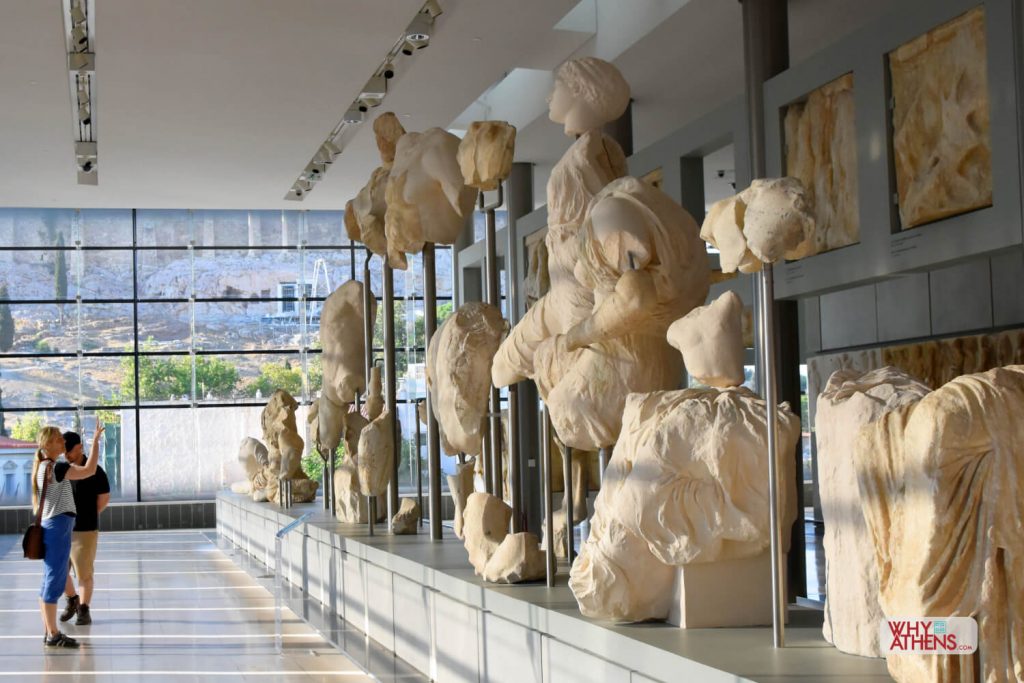
The sheer scale of the west pediment of the Parthenon can be seen up close at the Acropolis Museum. The statues depict the mythical contest between Athena and Poseidon. Photograph: Why Athens
The metope panels on the temple’s four sides illustrated legendary tales of the Greeks defeating the Trojans (north); the mythical Lapith people fighting unruly centaurs (south); and the Greeks battling the Giants (east) and Amazons (west). These age-old stories celebrated Greek civilisation’s rendering of order out of chaos, defeat of wild nature and military triumph over adversaries. Under Pericles, they became post-Persian-War propagandistic messages about the superiority of Greeks – especially Athenians.
The Parthenon frieze is traditionally understood to represent the Panathenaic Procession, an annual festival in honour of Athena. An intriguing alternative interpretation suggests the frieze’s eastern panels depict king Erechtheus offering his daughter as a sacrifice, in the presence of the Olympian gods, to ensure Athenian military success. Both views are powerful pro-Athenian messages: the first emphasising Athens’ reverence for Athena; the second promoting the idea of total sacrifice by all Athenians for the sake of their city’s survival and continued good fortune.
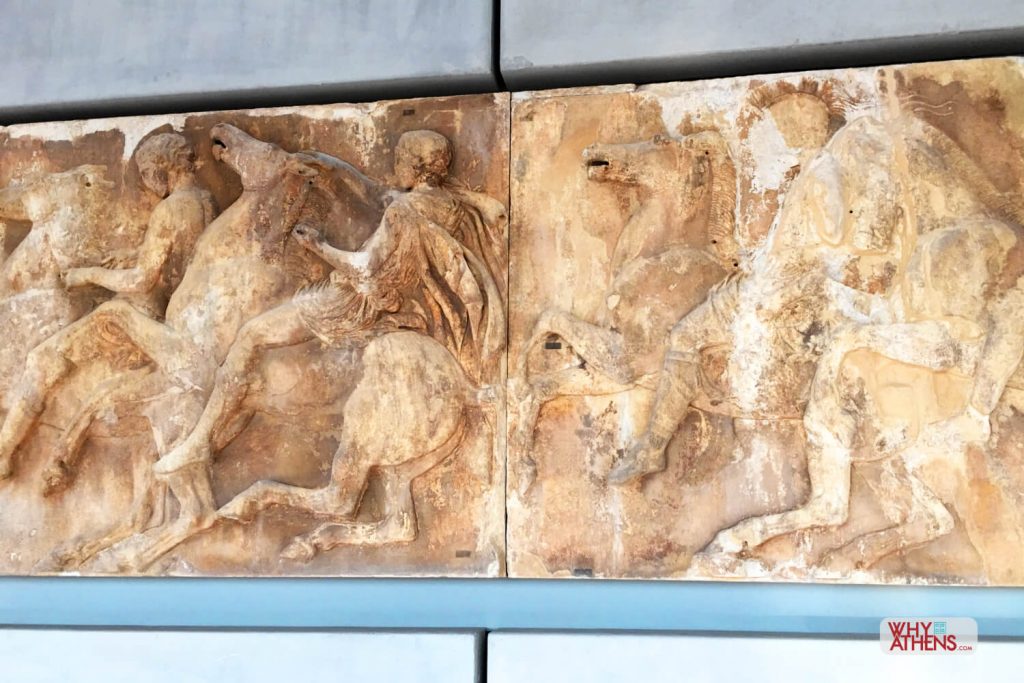
The Parthenon Frieze had a total length of 160 metres and is a continuous narrative carved in bas-relief. The horsemen allude to the newly democratised knighthood during Pericles’ leadership. Photograph: Why Athens
Also identified in the Parthenon frieze are said to be propagandistic images supporting Pericles’ recent democratic reforms. Specifically, horsemen in the frieze allude to the newly democratised knighthood, in which the state subsidised less prosperous knights. Moreover, the frequency of female figures reminded viewers of Pericles’ raising of Athenian women’s status as members of society – resulting from his decree that citizenship now required both an Athenian father and mother.
Pericles was a strong leader who seems to have roused controversy and criticism – judging from his Roman biography by Plutarch – due not only to his democratic reforms, but also his direction of the Delian League (the association Greek city-states founded in 478BC to continue the fight against the Persians) and consolidation of Athenian power into near-imperial authority. Pericles’ transfer of the League’s treasury from Delos to Athens in 454 BC and his Acropolis building program caused rancour among his opponents, writes Plutarch.
The following image shows what the Parthenon would have looked like in ancient times complete with coloured motifs.
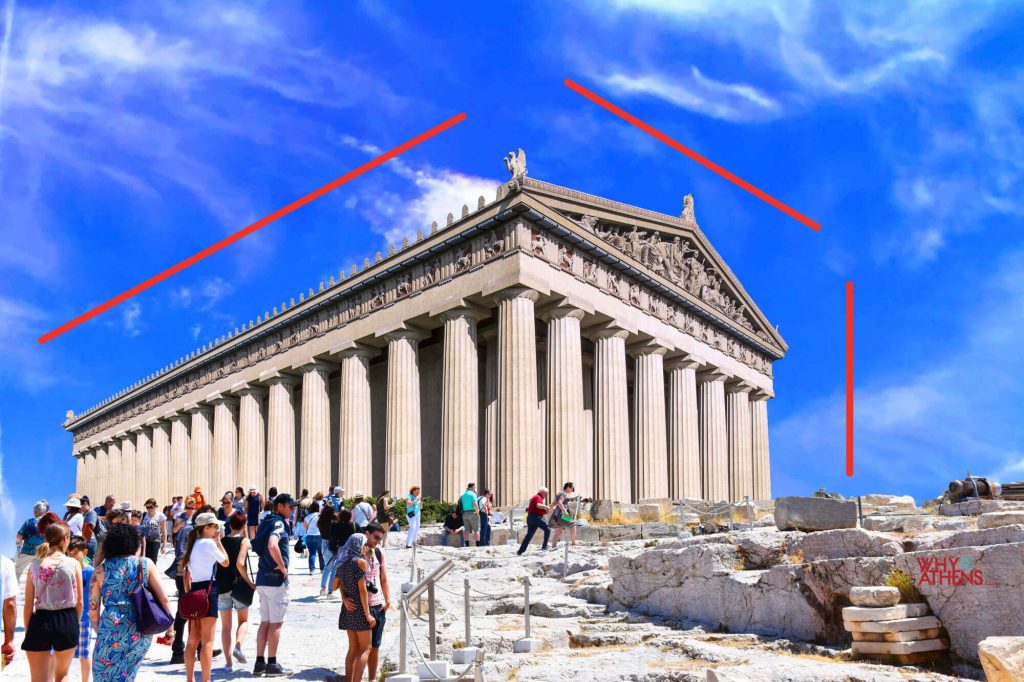
Still standing 2,500 years on. The Parthenon has survived the force of nature and visited by more than 2,700,000 people each year. Photograph: Why Athens
In spite of this, Pericles ultimately proved himself a great Athenian statesman and democratic pioneer who left his indelible mark on the Acropolis, the heart of his city, where Athenians regularly strolled, paused to read official announcements inscribed on path-side steles and admired the hill’s open-air art gallery of votive statues and gleaming, sculpture-adorned temples.
Further reading: 8 things you didn’t know about the Acropolis

